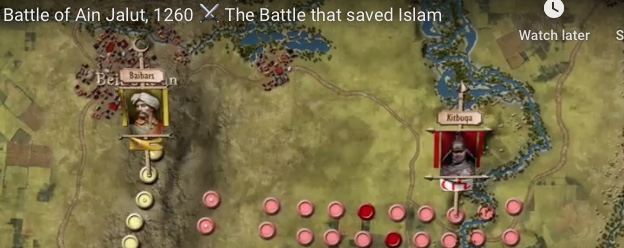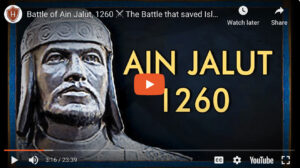Islam Saved Europe Twice

The Defeat of the Monghol at Ain Jaloot-Jalut Saved Europe
The Defeat of the Monghol at Ain Jaloot
Ain Jaloot (Jalut)—The iconic battle in Palestine in 1260 CE where Muslims halted the devastating Mongol invasion of Syria, Egypt, and North Africa. This battle also saved Europe from further Mongol disastrous advances. Per Dr. Adnan Ibrahim of Vienna, Austria, “Islam saved Europe twice—the first was the rescue of Europe from its darkness—the Dark Ages into the Renaissance, and the second was Muslim’s victory over the Mongol in the battle of Ain Jalut in Palestine.” He said: “The Mongol plans were to invade the world. They had already entered eastern Europe, destroyed Rasia, and set it two hundred years behind civilization. The Mongols devastated the lands of the Levant. They planned to continue to devastate Syria and Egypt, North Africa, then continue the destruction of Europe through North Africa into Spain, France, and meet their counterparts in eastern Europe.”
The first icon in saving Europe is Muslims’ enlightenment of Europe in its Islamic Civilization, which exhibits ration, freedom of thought, and religious tolerance. According to the French historian Max Vantajue, in his book, “The Arabic Miracle,” the Islamic Civilization was the “culmination of the Greeks, Hindu, Persian, and Egyptian civilizations together giving birth to a new Islamic Civilization characterized in the agility and fertility of algebra, the marvelousness of math, and the benefits of chemistry.” The Islamic Civilization liberated Europe’s oppressive church and religious persecution with the freedom of religion, free trade, and free education for all.
Muslims established institutions and universities in Andalucia, mainly in Cordoba, Seville, and Granada. In these institutions, sciences and arts in all fields of knowledge flourished in Spain, attracting students from France, England, and other European countries. The Muslims’ progressive and sophisticated Arabic manuscripts in Cordoba were translated into Latin, French, and other European languages.
The transformation of scientific knowledge and Islamic culture in Europe continued from the 8th to the 15th century. This was the period of incubation of the Renaissance. Dr. Ibrahim elaborates, “The European civilization was born from the womb of the Islamic civilization.” He maintained, “The European civilization was not accidentally born, nor was it a continuation of the ancient civilizations. Thousands of Arabic books were translated mainly into Latin. During this eight-hundred-year incubation period, the Islamic culture, the sciences of math, algebra, astronomy, physics, chemistry, drugs, arts, medicine, agriculture, and the scientific experimentation theories were seedling the Europeans’ blossom.”
The Islamic Civilizational transfer and influence into Europe came in many ways, including arts, sciences, poetry, and music. The most effective transfer was educational institutions and libraries. The reign of the Holy Roman Emperor, Frederick II (1123-1234 CE) marks one of the most influential periods of the transformation. Frederick II ruled Rome, Sicily, Italy, Germany, and the Kingdom of Jerusalem.
Under Cultural Transfer in Dispute, More recently, Dr. Dorothea Weltecke of Goethe University in Francfort writes, “It is often said that Frederick’s court in Sicily was a center of exceptional scientific significance and that Frederick had unusually close contacts to the Arab(ic) world of learning. They often represent Frederick as a man who transcended his time, who even shared our religious tolerance, rationalism, and secularism values and thus belongs more to our world than to the past.”
The Crusader Kingdoms posts a brief study on Fredricks II and Arab influence. Dr. Heiko Suhr of the University of Vechta, Germany, who did the work. It states: “Heiko Suhr in a short paper on this topic published in 1968, identified four factors that contributed to Frederick’s image as pro-Islamic: 1) his childhood in a Palermo allegedly dominated by Muslims, 2) the city of Lucera in Southern Italy populated by Sicilian Muslims who enjoyed complete religious freedom, 3) his culturally and religiously diverse court and his amicable correspondence with Muslim scholars and scientists, and finally, 4) his diplomatic relations with al-Kamil culminating in the return of Jerusalem to nominal Christian control without bloodshed.”
The Holy Emperor Fredrick II founded the University of Naples Federico II in Italy in 1224 CE. The earliest Western institution, the University of Salermo, was founded in the 9th century in Salerno, Italy. “The earliest Western institution that can be called a university was a famous medical school that arose at Salerno, Italy, in the 9th century and drew students from all over Europe. It remained merely a medical school, however. Per Dr. Ibrahim, “University of Salermo was practically an Islamic University with Arabic curriculums, much like those of Bagdad and Cairo, teaching medicine, science, and arts.”
Earlier, Gerbert of Aurillac, better known as Silvester (945-1003 CE), “took a firm hold of the Arabic numbers and became renowned for his scholarly achievements and advances in education.” Furthermore, Dr. Ibrahim states, “Gerberet learned the Maliki School of Fiqh (a complex of Islamic jurisprudence based on the Qur’an and the Prophet Muhammad teachings), which further boosted his scholarly position.”
Silvester’s enlightenment in Arabic numerals, sciences, and Islamic jurisprudence enabled him to advance through the Catholic Church posts and become the first French Pope (999-1003 CE). While in this influential position, he strove to run his knowledge and encouraged scholarship in Italy. Silvester died on May 12, 1003, in Rome, Italy, where the European Renaissance began in the early 1500s. See the Scientist Pope, by Nancy Marie Brown, author of The Abacus of the Cross.
Further Readings
https://www.noor-book.com/كتاب-المعجزة-العربية-pdf
How Islam Created the Modern World.
Reference:
https://www.britannica.com/biography/Sylvester-II
Richard Erdoes, 1000 AD (Berkley: Seastone, 1998), 60-61. http://everything2.com/title/Historical+Evidence+Regarding+the+Libraries+of+Muslim+Spain
Muslim Spain
http://www.webpages.uidaho.edu/engl257/Don%20Quixote/moorish_influence_on_renaiss.htm
Recommended Posts
الميزان المفقود
February 8, 2023
صُلح الحديبية – سُنَّة جَلية وفَتحٌ الهي
January 26, 2023

صُلح الحديبية – سُنَّةٌ جَلِيةٌ وفتح الهي عظيم
January 26, 2023


